Note - This will be Part 1 of a series focusing on the Broader Gulf Of Guinea Megalopolis.
For those of you who aren’t as Twitter addicted as myself, I ran into some controversy last week when I insulted the plot of the latest Disney Marvel film, Black Panther: Wakanda Forever with this tweet thread below,

While I was attacked and insulted by Black Twitter that day, it spoke to an important point, that Wakanda at this point is the most public symbol we have of African sovereignty + futurism. To everyone who’s a millennial and under, Wakanda is likely the most functional African state they have ever heard of, fictional or real.
It’s sad though, because Wakanda is fictional and will never be real(barring some Diasporic initiative to recreate it a la Afropolitan’s very fascinating digital society model). Wakanda will likely never be a real place and it has little to tell us about the African future.
What is real though is a massive story stirring on the West African coast, it is a 600 mile stretch of land that sits by West Africa’s Gulf Of Guinea. It stretches from Abidjan in the Ivory Coast all the way to Lagos in Nigeria, and if we want to be generous it really incorporates the entire Nigerian coast up until Port Harcourt. It is the densest part of the continent outside the Nile River Valley, includes 30+ million people, and by virtue of the growing density is also one of the more affluent parts of the continent at present, teeming with new expanding ports, new suburban developments, and a million questions on its future. I myself have tweeted about this emerging region in previous years,


A graphic which details Lagajan’s current size, as accepted by everyone.
Source - The Guardian
We can call this region Lagajan(Lagos to Abidjan), the Gulf Of Guinea Megalopolis. In this term, it borrows from BOSWASH, the huge megalopolis in the American northeast that extends from Boston to Washington DC over 450 miles and includes 55 million Americans. It is in the process of emerging as Africa’s first genuine Megalopolis, an extended urban area that incorporates multiple interconnected urban metro areas.
Lagajan could theoretically include the massive growth throughout the Nigerian coast and inner interior all the way up to Port Harcourt, which makes it a 950 mile monster concept.
Howard French has done a massive job chronicling this concept and expanding it here as well. As a young college undergraduate reading his initial take on the subject in The Atlantic, I was blown away by how he was able to synthesize something I had noticed but couldn’t quite put into words. This is my contribution to the discussion and encouraging more policy centered conversations around the topic.
The Region From Above
Before we dive into the specific major players, let’s check out the region as it currently exists in sum.
Major Cities - Abidjan, Accra, Lome, Cotonou, Lagos
Second Tier Cities - Takoradi, Cape Coast, Tema, Kumasi, Porto Novo, Ibadan
Population- If we add it all up at the moment, just focusing on Abidjan straight up to Lagos alongside the coast, the population of the region is likely around 35 to 40 million people currently.
The issue is this isn’t a well connected region at present. No cross-national rail links exist, there doesn’t yet exist a modern mega highway in the region(although efforts are being developed on this), and air links between the region are at best messy and overpriced. This means that at present its that rarest and most beautiful of creatures, a megalopolis in search of actual connective tissue.
Right now Lagajan is intensely siloed. Hardly anyone in Lagos feels like they’re in an actual emerging extended conurbation with Abidjan, who hardly feel that way with Accra, who hardly even feel that way with Lome. In that sense, its best to not yet overstate the region as it currently exists. Its a densely populated region in search of something more, whether it actually becomes that will be determined immensely by its national governments.
Regardless though, here is a brief sum up of all the major urban players in the region, and bear in mind these are brief for a reason.
Abidjan
The biggest city in Ivory Coast, it is the third most populated French speaking city in the world(After Kinshasa and Paris), and the sixth largest in Africa. Abidjan is an emerging urban behemoth. The metro area at present has between 7.5 to 8.5 million people and continues to grow in spades, driven not only by domestic migration but also international migration, particularly from the Sahel.
What makes Abidjan unique is not only the fact that its such a large city and growing rapidly, but also the fact that by African standards it has a large degree of industrialization, Abidjan hosts a bevy of food processing, textiles, and chemical plants, it even hosts an oil refinery as well. This makes its local economy arguably the second most diversified in West Africa alone.
In terms of the city’s culture and lifestyle, the city stands out firstly for how tightly its embraced French. In most of Francophone Africa, French is at best a second language and more often a third language, but in Abidjan French is now the dominant native language for those born there + long term residents. There is even a localized French dialect replete with its own slang and cues that would comfortably find fans throughout the Francophone world.
Abidjan has for decades served as a tentpole city for migrants from the broader Sahel. Migrants from Burkina Faso, Guinea, Liberia, Togo, Benin, and Mali all have enclaves in the city and as a result the city is comfortably cosmopolitan. Even beyond this rich African presence Abidjan is also home to large French and Lebanese immigrant populations. 3 - 5 % of the city is at least non-black which also places Abidjan as an outlier in the region.
The city’s most distinctive district is Cocody which for Nigerians you can visualize as the Lekki of Abidjan but even better, its a elegant urban district that features some of Abidjan’s most prominent high streets, upmarket villas, and a distinguished embassy presence.
A beach located along the coastline of the Cocody district.
Takoradi
Takoradi is a part of an emerging metro area with its twin city, Sekondi. Together they form a metro area of around 750k to a million residents, its about 190 miles to the east of Abidjan and is in Western Ghana. The metro area has over the past decade gained a lot of traction off the fact that it is the hub of the Ghanaian oil industry, which while it hasn’t enriched the broader country, has certainly done enough to change the fortunes of what was just a generation ago, a more sedate beach town.
This has done much to culturally transform the town, migrants now come from throughout Ghana rather than just regionally. Schools are sprouting up everywhere in the area, and in terms of pure political relevance, the area gets more focus from the major Ghanaian political parties. Within a decade, this metro area is likely to even double in size from its current base. Its one to watch for sure.
Accra
Accra is justly famous, not only as a business hub in West Africa as a whole, but also for its broader cultural relevance within the Black World. I myself have a few colleagues + friends who have relocated entirely to the city off this relevance, and this relevance will only grow as the city grows as well. Accra currently has about 5.5 million to 6.5 million citizens in its broader metro area, and it is a city dotted with a large number of distinctive neighborhoods, from the grittiness of Jamestown to the posher surroundings of Osu and Cantonments.
Accra has over the past decade emerged as a general must travel spot within the Black travel world through its tourism initiatives reaching out to the diaspora, which has made visits to Accra and historical attractions more of a must for that population.
That cachet has correlated with a growing burst of economic activity in general as well as a binge of new suburban housing developments and projects coming onto the market. Accra as a city in its best corners feels as some West African newspapers would call it, “ultra-modern”, a modernized West African Aesthetic.
Accra has always attracted immense domestic migration but its also just like Abidjan now becoming a more cosmopolitan city. Tons of Togolese, Liberians, Nigerians, Ivorians, and even from far afield as Mali now openly live in the city and as the region continues to be on the whole generally economically turbulent, Accra appears like a lighthouse amid the shore.
Tema
Tema is a part of the Accra metropolitan area, but it has gradually started to emerge as the clear second city of the metropolitan region. It hosts about 200k people and was initially created to serve as the dominant seaport for Ghana and specifically for Accra in the 1960s. Over the past generation it has served as a suburban escape for middle class Accra families who desire more space and amenities.
The seaport there has seen greater investment in recent years and has been expanded, which bodes well for Ghana’s export ambitions as well as job creation. This job creation can be seen by the fact that Tema is arguably Ghana’s most industrialized city, the city boasts aluminum, steel, processed food, chemicals, and cement plants, and this concentration of these jobs generally ties in well with Tema Harbour as the products are made for both domestic use as well as exports.
Tema’s current status and future indicates that as Lagajan increases in population there will be more Temas that will inevitably emerge, especially around Lagos, Accra, Lome, and Abidjan. Suburban edge cities that in their own right could also play a role as job creation vehicles and potentially the vanguards of West African industrialization.
Kumasi
Now some may say I’m bending the borders of the Megalopolis by including Kumasi, but Kumasi is about only 154 miles from Accra northwards, and in an actually integrated megalopolis with sufficient transport links, its close enough that it would be formally in the gravity of the region. Also as Ghana continues to expand in population, the Accra - Kumasi corridor itself is also becoming more densely populated, so it also resembles the coastal density of settlements we see. Kumasi is Ghana’s Second City, but unlike most second cities in Africa its not vastly overshadowed by Accra. It has a metro area population of about 4 to 5 million people so its within Accra’s metro area population, instead of the usual 10X - 80x differentials we see between primate city and secondary cities in Africa.
What makes Kumasi so distinctive is also its cultural heritage. It is the historical heart and center of the Ashanti nation, one of Ghana’s core ethnic nations, and in many way a part of an extended meta-ethnicity that has at its core the Twi language and the old historical fabric of the Asante empire. Kumasi isn’t as cosmopolitan as Accra, its not as glitzy, but it is a real proud city with actual locals and far more of a “Ghanaian” feel. They also have an entire indoor marketplace, a great adaptation of the mall but oriented around traditional African commerce.

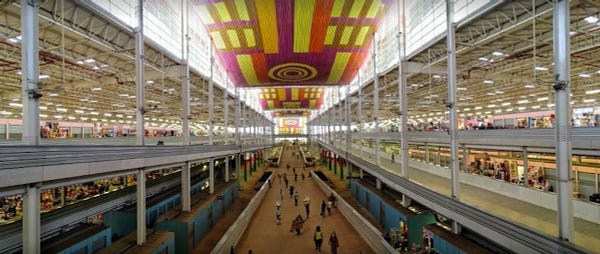
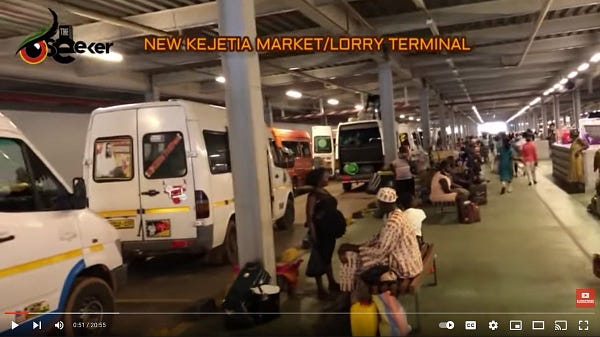
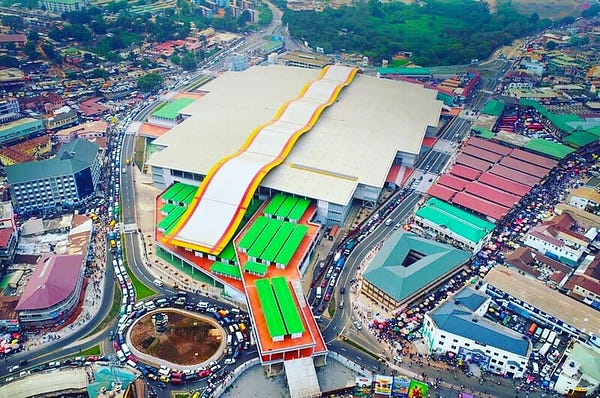
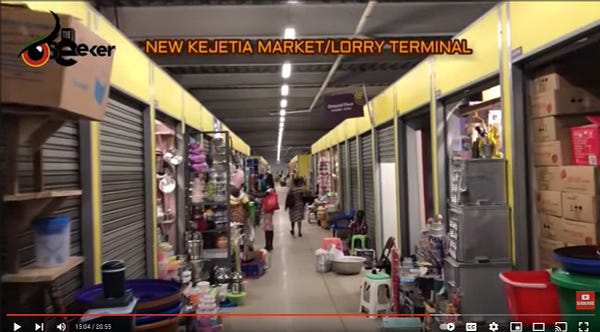
Lome
Lome is the city of my birth, and it is a charming one. Unlike Accra which does border the ocean but feels oriented away from it, Lome is all about its beaches and coastline, and there are a range of hotels as well as restaurants that enliven that stretch. Lome now boasts two million people within its metro area, about 25 % of the population of Togo. When I was born there in the early to mid 1990s it only had 700k people, it has tripled its population within my lifetime, and the growth isn’t poised to stop anytime soon.
Togo is an interesting place, in part because like Benin it forms a kind of French pause between the larger economies of Ghana and Nigeria, and in a way both serve as a kind of French attachments to their larger Anglo neighbors. Lome in itself serves as a transnational border region with next door Aflao in Ghana. Lome, being right at the Ghanaian border is that rare blend of national capital + border town. The border itself between Lome and Aflao is one of the busiest on the African continent. The broader Ewe region in Ghana has great commonalities with the Ewe of Southern Togo, kinsmen cut by a border drawn up by the British and French post WWI.
Lome as a city is angling to become a regional hub. Its port now stands as one of the largest in the region and has branded itself as a gateway to nearby Lagos, just 185 miles to the East. It hosts the headquarters of some of West Africa’s biggest regional companies such as Asky and Ecobank. Lome recently also served as the landing point for a new underwater Google fiber optic cable that should increase internet speeds along the West African coast.
While I do have many faults with Togo’s government(in part the fact that it is a family run autocracy), I will give them credit that they do recognize the glaringly obvious fact that Togo’s future needs to be one as a lived regional hub. There are actions they can do to speed this up, such as adopting English as an official language and perhaps displacing French, just as Rwanda did a generation ago to great success. They could also make a greater play for talented Nigerians and Ghanaians seeking a neutral base from which to build for West Africa as a whole. Whether they can do this is an open question, and serves as a big open question for my ancestral homeland.
Cotonou
Our journey along the coast continues in Cotonou, Cotonou lies just 76 miles from Lagos, and in a just world it should already be a formal part of the Lagos metro area. Cotonou is the Beninois economic capital, it probably has a million people maximum in its metro area and of course from Cotonou there is a sprawl of settlements that continues until you formally cross over into Lagos State.
Cotonou in its current state is quite frankly a disappointment, the highway/land route to Lagos State is quite patchy and difficult to travel to, so its land linkage to Lagos is troublesome, which is an outrage in 2022 and its on both the Beninois and Nigerian governments for neglecting this.
In an ideal world, Cotonou would be a big player in a Greater Lagos metropolitan area. There would be commuter rail access with multiple stops throughout the city, a border pass could be created that would enable easy seamless trips between Benin and Lagos State, and if a regional high speed railroad ever got enabled, Cotonou to Lagos could be a straight 15 to 20 minute ride. Cotonou in this scenario would not only be enriched, but it would serve as a valuable suburban edge city for Lagos, similar to a role Ibadan has begun to play as well.
Cotonou and Lagos share a similar ethnic fabric, rich market traditions, but yet there are no rail connections, and the road situation isn’t ideal. The interface between the two highlights one of the key issues of viewing this as a formally emerged megalopolis at the moment. There’s a long way to go.
Lagos
There has already been immense amounts spilled on Lagos. What more could one write about Las Gidi? With a population in the metro area of anywhere between 15 to twenty million, Lagos is an African urban machine and its largest metropolitan area. If it was an independent country it would formally rank comfortably as one of the ten richest states on both GDP and GDP per capita rankings. Its host to the Nigerian economic engine and plays host to practically every major Nigerian corporation, as well as an extremely vibrant venture funded tech sector that has generated plaudits for Nigeria.
All these good things aside, Lagos is a city experiencing major growth pains. It is a city that has long stood as a massive opportunity for many across Nigeria so it has absorbed a lot of rural to urban migration over the past few decades. The city chokes with congestion from 4 AM to midnight, it still lacks a mass rail transit system, and quality of life issues are still a recurrent annoyance from water quality to electricity shortages.
Lagos quite frankly is HARD. Its a megacity but its a megacity increasingly testing the bounds of how big a city can get without underlying connective tissues. At times the social and wealth divides in the city make it appear as a tale of three cities in one, let alone two. There is a Lagos of poverty, a Lagos of the working class, and a Lagos of the elites, and they’re pretty enclosed towards each other, abstract to the ones who don’t live in the others.
But yet even with all these issues Lagos does matter quite a lot. It is not only an economic magnet, but the cultural heartbeat of Africa itself. This is where Afrobeats is produced in mass, where the financing for Nollywood films are secured and then produced, and the nightclubs where the dances that then spread continentally are invented. Lagos is every bit as relevant now as Atlanta and Los Angeles are in terms of Global Black popular culture, which if you had told anyone in 2000, that would have been a laughable statement.
Lagos though in it strengths and negative embodies a lot about the broader region. It has an increased economy of scale, but fails to capitalize it based off regional dysfunctions and a lack of systematic thinking from its local elites. Some of these major challenges we will look at in Part II and how they can possibly be navigated around.


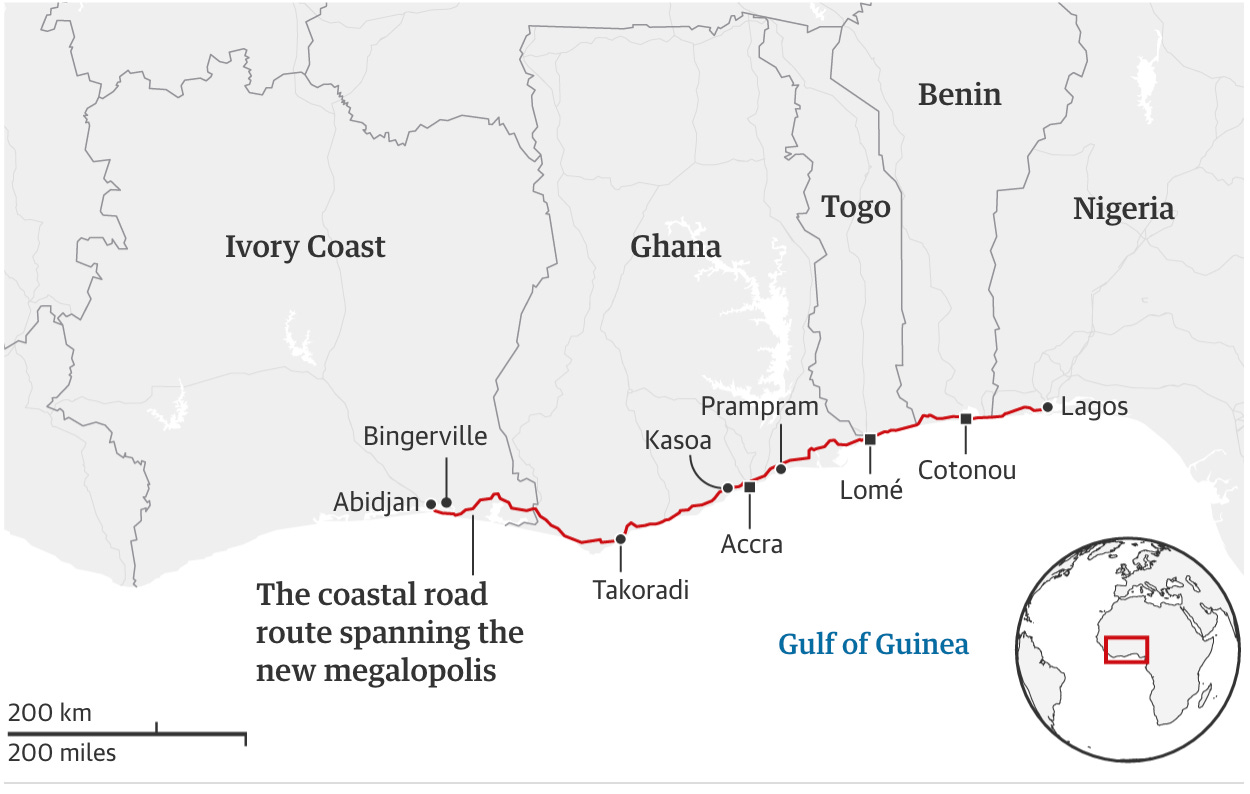

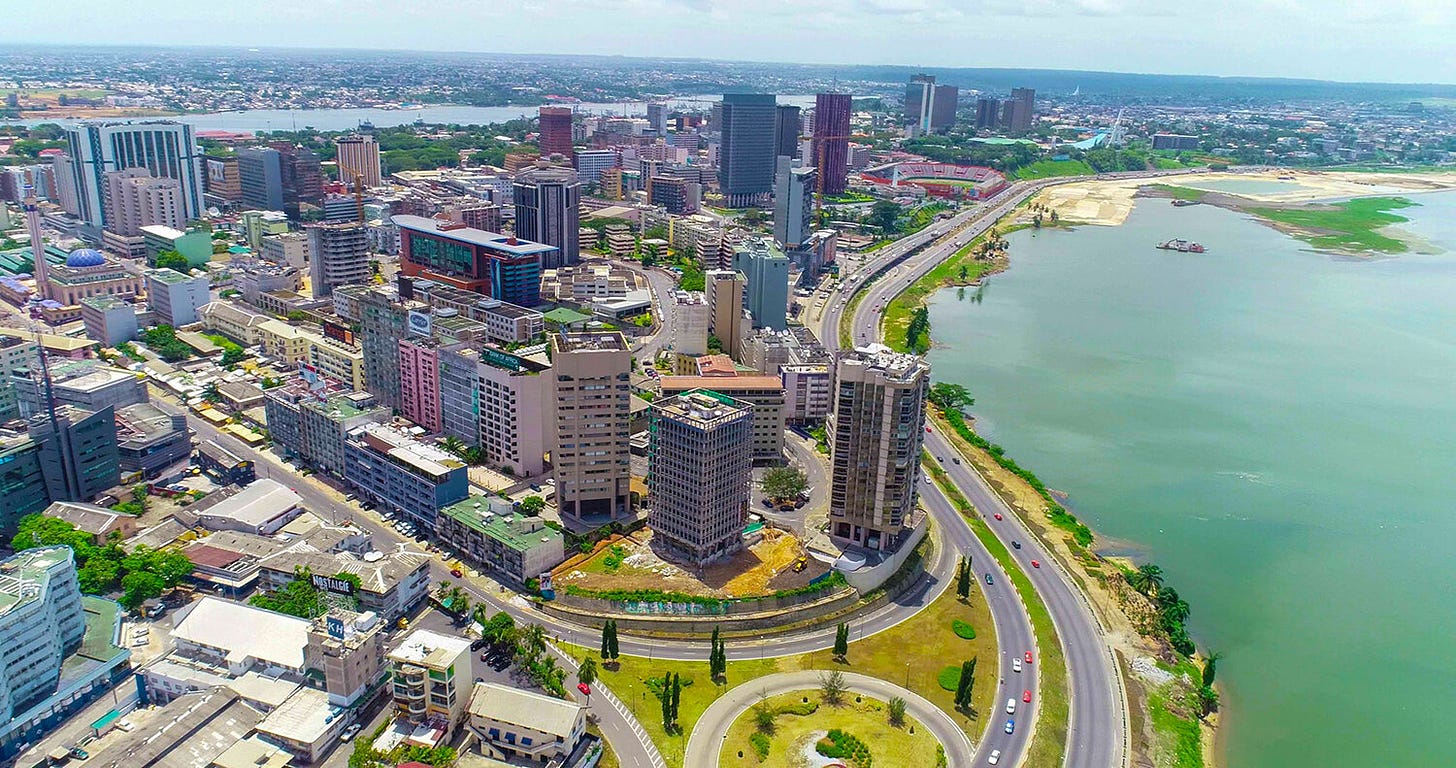

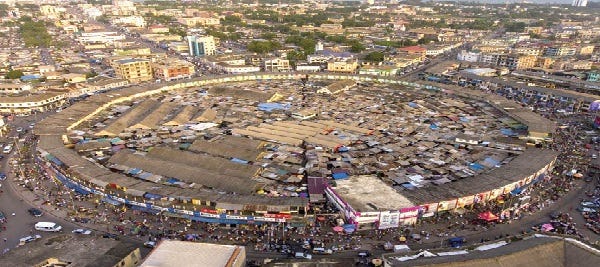
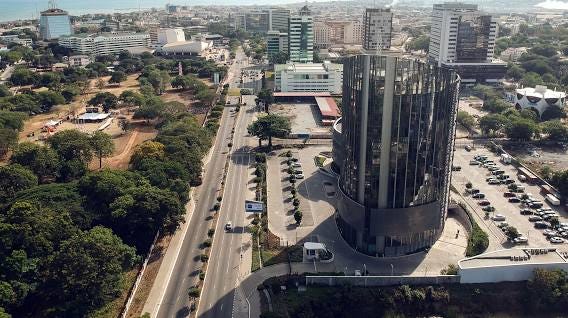

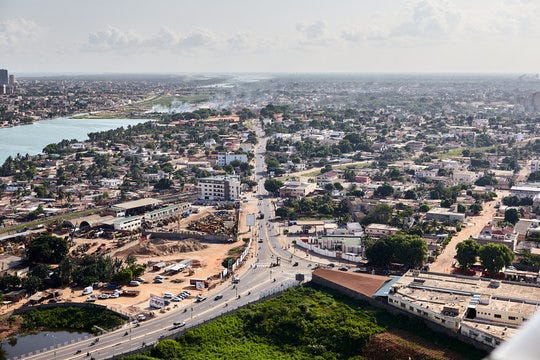
Great read, thank you for sharing and all of the research involved. what would an infrastructure project look like to connect these cities? anything underway to the best of your knowledge?
Good read
More context on Benin will have been great.